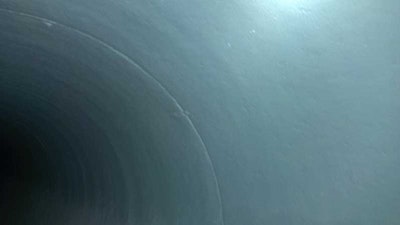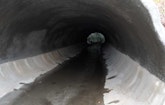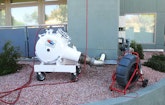Interested in Cleaning?
Get Cleaning articles, news and videos right in your inbox! Sign up now.
Cleaning + Get AlertsLarge arched culverts repaired from within
Problem: Arched culverts made of bolted, corrugated metal plates are a common feature in Ohio’s sewer infrastructure landscape. The Ohio Department of Transportation had previously repaired the inverts of two large culverts by paving them with concrete. Subsequently, the two culverts — 12 feet 6 inches wide and 7 feet 11 inches tall, running for 90 feet under a two-lane rural road near Cincinnati — were rusting and leaking from the arched upper sections and required full structural repair.
Solution: ODOT selected CentriPipe from AP/M Permaform to repair the two arched culverts. The centrifugally cast concrete pipe solution requires minimal staging area and results in a smooth, watertight structural liner within the host pipe. To ensure the design thickness was met, hundreds of self-tapping screws were set into the metal plate, all of which protruded two inches above the culvert corrugations. The cementitious material was applied in several layers, no more than 1/2 inch thick. The material, PL-8000, cures quickly and bonds well to itself so layers can be applied on successive days.
Result: Using the CentriPipe system, sewer joints and inverts were repaired and several passes were made through each culvert, applying thin layers of PL-8000 with each pass until a total thickness of 2 inches was reached, resulting in a cost-effective, structural solution without traffic closures. 800/662-6465; www.centripipe.com.
Lining system used to create leak-free roof drains
Problem: Located in Las Vegas, the Modern is a condominium complex consisting of nine buildings and 83 units. After undergoing renovations, six of the nine buildings were found to have nails and screws puncturing PVC roof drains with some in the 90-degree bends. Replacement was not an option, as it would have required tearing open the newly renovated walls and cabinetry.
Solution: The Modern contacted a certified Flow-Liner installer to remove the protrusions and line the roof drains to prevent any future leaks or damage to the condominium. The installer used a robotic cutter to remove or grind down the protruding nails and screws. Once the protrusions were cleared, a CIPP liner was installed, sealing any leaks in the pipes.
Result: Lining was successful despite an added degree of difficulty; the liner had to be inverted from the outlet end of the roof drain vertically to the inlet located on the roof. What could have taken several months and caused much disruption took less than four weeks with no disruption to the newly renovated facility. 800/348-0020; www.flow-liner.com.
Coating used on air-conditioning return lines
Problem: A southeastern U.S. nuclear energy plant was suffering from corrosion in high-pressure return lines that service its AC units. Two separate 14-foot-long, 4-inch-diameter lines each hold 125 psi and needed to be rehabilitated or replaced. The steel pipes were located in a small emergency control room with very little access and many existing underground utilities to maneuver around.
Solution: The energy plant researched and weighed the options between rehabilitation and total pipe replacement. Rehabilitation was the best option using the pipe coating method, which is the fastest, most efficient option with little impact and interruption and no excavation. First the lines were cleaned using high-speed cleaning chains with a Picote Solutions Maxi Miller drive unit. Following the cleaning process came the application of the ASTM-certified 100 percent solids epoxy using brushes, supply hose (to carry the epoxy) and a camera connected to a Mini Miller, which rotated the brushes. The first coat took an hour to complete with a two-hour cure time followed by two more coats. Contrasting colors of white, gray and white were used with each coat to verify even coverage with each pass.
Result: The job was completed in one day, followed by a 24-hour final cure period before the lines were put back into service. The plant was satisfied with the quality of the materials, which exceeded its stringent standards and expectations. 219/440-1404; www.picotesolutions.com.
Polyurea lining used to rehabilitate 78-year-old steel waterline
Problem: A 1/2-mile-long section of 78-year-old unlined, steel potable water pipeline in Tacoma, Washington, was damaged after years of service and suffered several serious leaks. Businesses and residences surrounded the pipeline, making excavation and replacement an expensive and impractical option. Tacoma Water required an effective pipeline repair solution and extended-life corrosion control strategy.
Solution: Pipeliner 5000 11-70 PW spray-applied polyurea lining from Rhino Linings was selected to repair the aging and badly damaged pipe without the need to excavate and physically replace the pipeline. Specifically designed for potable water applications, the lining passed the testing requirements of the NSF/ANSI-61 Section 5 (2012) potable water standard and is Truesdail Laboratories listed. The 58-inch-diameter pipeline was first dewatered, patched and cleaned. Pipeliner 5000 11-70 PW was spray-applied 350 to 400 mils thick, or almost 3/8 inch, using a robotic spray head designed to seal leaks and provide structural support. It can also be applied using high-pressure, 1-to-1 spray equipment.
Result: The lining project was completed in four weeks with minimal disturbance to the surrounding businesses and residences. Tacoma Water is pleased with the quick turnaround time, and expects the newly coated pipeline to serve for a minimum of 50 years. 800/422-2603; www.rhinolinings.com.









